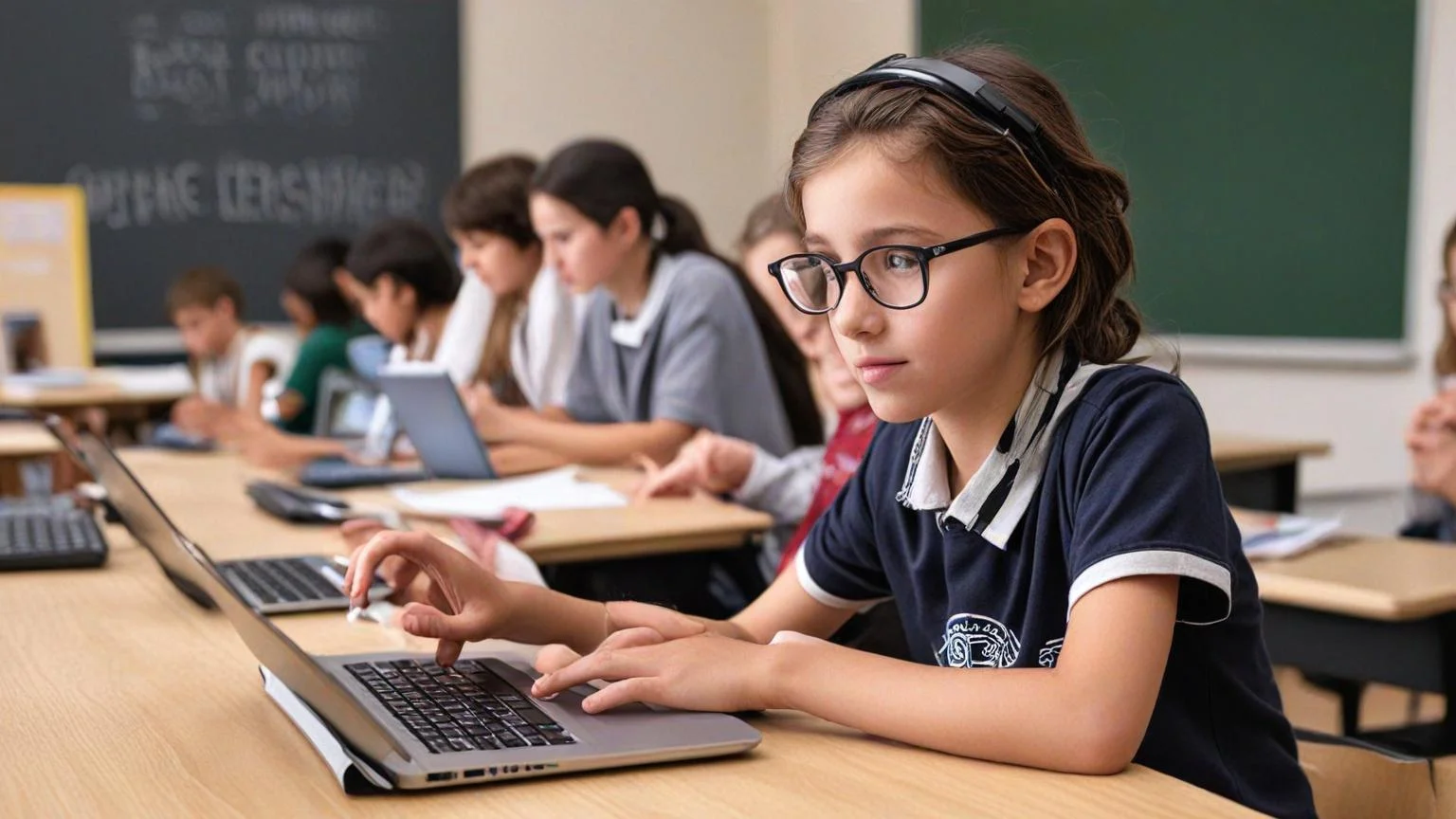Technology has become an integral part of modern education, reshaping how we teach, learn, and interact in the classroom. From digital tools to online resources, technology is revolutionizing the educational experience. This article explores the role of technology in modern education, examining its impact on teaching, learning, and the future of education.
What is the Role of Educational Technology in Modern Teaching?
Educational technology refers to the use of digital tools and resources to enhance teaching and learning. It includes everything from interactive whiteboards to educational apps. Here are several key roles that technology plays in modern teaching:
Enhancing Learning Experiences
Technology enriches the learning experience through interactive and multimedia resources.
- Interactive Learning Tools: Tools like smartboards and digital simulations engage students and make learning more dynamic.
- Example: A virtual lab allows students to conduct experiments that might be too dangerous or expensive in a physical lab.
- Example: A virtual lab allows students to conduct experiments that might be too dangerous or expensive in a physical lab.
- Multimedia Resources: Videos, podcasts, and animations can explain complex concepts in an accessible way.
- Example: Educational YouTube channels offer visual explanations of scientific theories and historical events.
Facilitating Access to Information
Technology provides students with easy access to a vast amount of information and resources.
- Online Databases and Libraries: Digital libraries offer access to academic journals, e-books, and research papers.
- Example: JSTOR and Google Scholar are online databases that provide access to academic articles.
- Example: JSTOR and Google Scholar are online databases that provide access to academic articles.
- Educational Apps and Platforms: Apps like Khan Academy and Coursera offer tutorials and courses on various subjects.
- Example: Khan Academy provides free lessons in subjects like math, science, and humanities.
Supporting Personalized Learning
Technology allows for personalized learning experiences tailored to individual needs.
- Adaptive Learning Technologies: Tools that adjust the difficulty of tasks based on student performance.
- Example: Programs like DreamBox adjust math problems based on the student’s answers and progress.
- Example: Programs like DreamBox adjust math problems based on the student’s answers and progress.
- Learning Management Systems (LMS): Platforms like Canvas and Blackboard facilitate customized learning paths and feedback.
- Example: Teachers can create individualized assignments and track student progress through an LMS.
Encouraging Collaboration and Communication
Technology fosters collaboration and communication among students and teachers.
- Collaborative Tools: Platforms like Google Classroom and Microsoft Teams enable group projects and discussions.
- Example: Students can work on a shared document in real-time using Google Docs.
- Communication Platforms: Email, forums, and chat systems connect students with teachers and peers.
- Example: Online discussion boards allow students to ask questions and share ideas outside of class hours.
Improving Teaching Efficiency
Technology streamlines administrative tasks and enhances teaching efficiency.
- Administrative Tools: Automated grading systems and attendance trackers reduce the administrative burden on teachers.
- Example: Tools like GradeBook automate the grading of assignments and quizzes.
- Example: Tools like GradeBook automate the grading of assignments and quizzes.
- Lesson Planning and Resources: Teachers can access a wide range of teaching resources and lesson plans online.
- Example: Websites like Teachers Pay Teachers offer pre-made lesson plans and teaching materials.
What Role Does Technology Play in Education Today?

Technology plays several crucial roles in today’s education system, transforming traditional teaching methods and expanding opportunities for learners. Here are some of the primary roles of technology in modern education:
Interactive Learning Environments
Technology creates interactive learning environments that engage students and make learning more enjoyable.
- Gamification: Incorporating game elements into lessons to motivate and engage students.
- Example: Educational games like Prodigy Math make learning fun and competitive.
- Example: Educational games like Prodigy Math make learning fun and competitive.
- Virtual Reality (VR) and Augmented Reality (AR): Providing immersive experiences for exploring complex concepts.
- Example: VR field trips allow students to explore historical sites or outer space.
Remote Learning and Flexibility
Technology enables remote learning, offering flexibility for students and teachers.
- Online Classes: Platforms like Zoom and Google Meet facilitate live, interactive online classes.
- Example: Virtual classrooms allow students to attend lectures and participate in discussions from home.
- Example: Virtual classrooms allow students to attend lectures and participate in discussions from home.
- Asynchronous Learning: Providing resources and assignments that students can access at their convenience.
- Example: Pre-recorded lectures and online discussion boards enable students to learn on their own schedule.
Data-Driven Instruction
Technology supports data-driven instruction by providing insights into student performance.
- Educational Analytics: Tools that analyze student data to inform teaching strategies.
- Example: Learning analytics platforms offer insights into student engagement and achievement.
- Example: Learning analytics platforms offer insights into student engagement and achievement.
- Progress Tracking: Systems that monitor student progress and identify areas for improvement.
- Example: Teachers can use data from online quizzes to identify which concepts need more review.
Enhanced Teacher Professional Development
Technology supports teacher professional development through online resources and communities.
- Online Training Programs: Courses and webinars for teachers to learn new skills and strategies.
- Example: Websites like Edutopia offer resources for teacher training and professional growth.
- Example: Websites like Edutopia offer resources for teacher training and professional growth.
- Teacher Communities: Online forums and social media groups for sharing ideas and best practices.
- Example: Twitter chats and LinkedIn groups provide platforms for teachers to collaborate and learn.
Supporting Diverse Learning Needs
Technology addresses diverse learning needs by offering various educational resources.
- Assistive Technologies: Tools designed to support students with disabilities.
- Example: Text-to-speech programs and screen readers assist students with visual or reading impairments.
- Example: Text-to-speech programs and screen readers assist students with visual or reading impairments.
- Language Learning Apps: Apps that support students learning new languages.
- Example: Duolingo offers language courses and practice exercises for multiple languages.
What is the Role of Modern Technology?

Modern technology encompasses a broad range of tools and innovations that impact various aspects of education.
Innovation in Teaching Methods
Modern technology introduces innovative teaching methods that improve the learning experience.
- Blended Learning: Combining face-to-face instruction with online resources and activities.
- Example: A course that includes both in-person lectures and online assignments.
- Example: A course that includes both in-person lectures and online assignments.
- Flipped Classrooms: Students learn new content at home and apply it in class.
- Example: Students watch lecture videos at home and engage in discussions during class.
Access to Global Learning Opportunities
Technology connects students to global learning opportunities and resources.
- Global Collaboration: Projects and exchanges with students from other countries.
- Example: International pen pal programs and collaborative projects with schools abroad.
- Example: International pen pal programs and collaborative projects with schools abroad.
- Global Educational Resources: Access to educational materials from around the world.
- Example: Online courses from universities in different countries.
Expanding Educational Access
Technology helps expand access to education for underserved populations.
- Online Learning Platforms: Providing educational opportunities to students who cannot attend traditional schools.
- Example: Khan Academy and Coursera offer free and affordable educational resources.
- Example: Khan Academy and Coursera offer free and affordable educational resources.
- Mobile Learning: Using smartphones and tablets to access educational content.
- Example: Educational apps available on mobile devices for learning on the go.
Supporting Lifelong Learning
Technology supports lifelong learning by providing resources for continuous education.
- Adult Education Programs: Online courses and resources for adult learners.
- Example: Udemy and LinkedIn Learning offer courses for personal and professional development.
- Example: Udemy and LinkedIn Learning offer courses for personal and professional development.
- Self-Paced Learning: Opportunities for learners to study at their own pace.
- Example: Self-paced online courses and certifications.
How Will Modern Technologies Change the Way of Teaching?
Modern technologies are continually evolving, and their impact on education is profound. Here are some ways modern technologies will change teaching in the future:
Increased Use of Artificial Intelligence (AI)
AI will play a significant role in personalizing education and automating tasks.
- Personalized Learning: AI-powered systems will tailor educational content to individual student needs.
- Example: AI tutors that provide personalized feedback and support.
- Example: AI tutors that provide personalized feedback and support.
- Automated Administrative Tasks: AI will handle administrative duties like grading and scheduling.
- Example: Automated grading systems for assignments and exams.
Expansion of Virtual and Augmented Reality
VR and AR technologies will offer more immersive and interactive learning experiences.
- Immersive Learning Environments: VR simulations for subjects like history, science, and art.
- Example: VR experiences that let students explore ancient civilizations or conduct scientific experiments.
- Example: VR experiences that let students explore ancient civilizations or conduct scientific experiments.
- Interactive Lessons: AR applications that overlay digital information on the physical world.
- Example: AR apps that bring historical events or scientific concepts to life.
Growth of Online and Hybrid Learning Models
The popularity of online and hybrid learning models will continue to grow.
- Hybrid Learning Models: Combining online learning with traditional classroom instruction.
- Example: A course that integrates online lectures with in-person labs or discussions.
- Example: A course that integrates online lectures with in-person labs or discussions.
- Online Course Platforms: Expanding access to education through a variety of online course offerings.
- Example: Platforms offering a wide range of courses from different institutions.
Development of Advanced Educational Technologies
New technologies will continue to advance the field of education.
- Smart Classrooms: Classrooms equipped with advanced technology for interactive learning.
- Example: Smartboards, digital projectors, and wireless connectivity for collaborative activities.
- Example: Smartboards, digital projectors, and wireless connectivity for collaborative activities.
- Innovative Learning Tools: Development of new tools and resources for teaching and learning.
- Example: Interactive educational games and advanced educational apps.
Summary Table of Technology’s Role in Modern Education
| Technology Aspect | Role and Impact |
|---|---|
| Interactive Learning Environments | Engages students through multimedia resources and immersive experiences. |
| Access to Information | Provides access to online databases, educational apps, and digital libraries. |
| Personalized Learning | Offers adaptive learning technologies and customized learning experiences. |
| Collaboration and Communication | Facilitates group work, discussions, and connections between students and teachers. |
| Teaching Efficiency | Streamlines administrative tasks and enhances lesson planning. |
| Remote Learning | Offers flexible learning options through online classes and asynchronous learning. |
| Data-Driven Instruction | Utilizes analytics and progress tracking for informed teaching strategies. |
| Professional Development | Provides resources and communities for teacher training and growth. |
| Diverse Learning Needs | Supports students with disabilities and offers language learning opportunities. |
| Innovative Teaching Methods | Introduces blended learning, flipped classrooms, and new pedagogical approaches. |
| Global Learning Opportunities | Connects students to international resources and collaboration. |
| Expanding Educational Access | Provides educational opportunities for underserved populations. |
| Lifelong Learning | Supports ongoing education for personal and professional development. |
| AI in Education | Personalizes learning experiences and automates tasks. |
| Virtual and Augmented Reality | Offers immersive and interactive learning environments. |
Conclusion
Technology plays a transformative role in modern education by enhancing learning experiences, providing access to information, and supporting diverse learning needs. From interactive tools to online resources, technology offers numerous benefits for students and teachers alike. As technology continues to advance, it will further reshape teaching methods and educational opportunities.
By embracing these technologies and understanding their impact, educators and learners can prepare for the future of education. The ongoing development of new tools and methods will drive the evolution of teaching and learning, making education more engaging, accessible, and effective.

